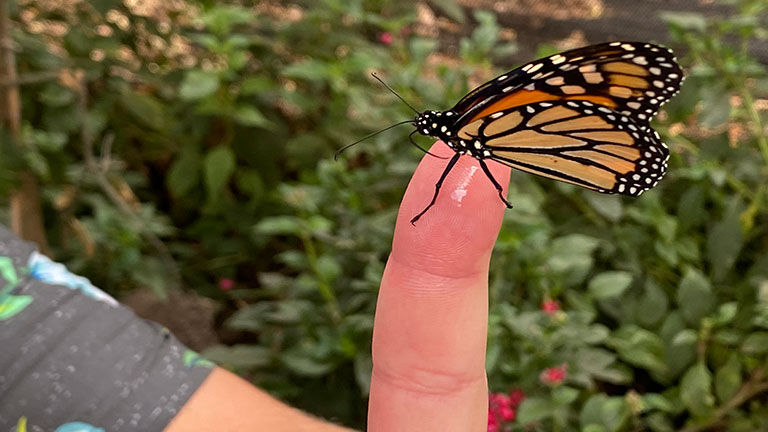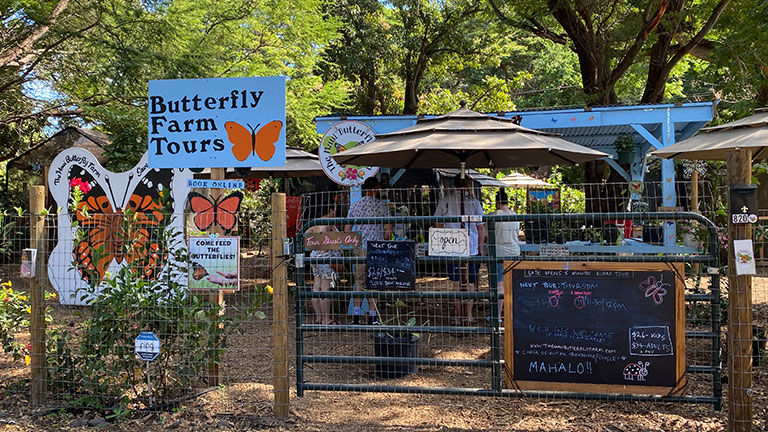I can barely feel the monarch butterfly as it sips a drop of hibiscus nectar on my forefinger. No surprise: It’s small and delicate and weighs just half a gram, but its name is apropos nonetheless. With wings flaunting a striking pattern of orange, black and white, it is regal, elegant — truly a royal in the insect world.
I’m at The Maui Butterfly Farm, which owners Siobhan Wilson and her husband, Geoffrey, opened in October 2020 on a 10,000-square-foot parcel of West Maui land that was once part of a camp for Japanese sugarcane plantation workers. The farm serves as both an educational center and a breeding site for gulf fritillary, citrus swallowtail and monarch butterflies.
Initially, the couple raised the butterflies at their upcountry Maui home to sell for parties and weddings. Then customers expressed interest in seeing the process.
“They loved it,” said Wilson, whose fascination with butterflies dates back some 30 years, to when she was a young girl in her native Oxford, England. “They were so amazed when we showed them around and explained things that we thought, ‘We’re doing this all wrong. We won’t sell butterflies; instead, we’ll do tours that teach people about them.’”
The Maui Butterfly Farm Tour
A 45-minute tour of The Maui Butterfly Farm is an excellent primer on butterflies presented through hands-on experiences. Clients can examine citrus, lilikoi (passionfruit) and milkweed leaves for poppy seed-sized eggs; hold a plump caterpillar; and feed fruit and flower nectar to a butterfly that’s resting on their finger. If they’re lucky, they might even see a butterfly emerge from a chrysalis.
 Clients can feed nectar to a butterfly as it rests on their finger.
Clients can feed nectar to a butterfly as it rests on their finger.
Credit: 2021 Cheryl Chee TsutsumiI’m thoroughly engaged as Wilson shares fact after fascinating fact about the amazing creature most people primarily appreciate for its beauty. Among them: Butterflies need warmth to fly; if the temperature drops below 60 degrees, they become immobile.
They find food sources — specifically, plant nectar — via taste receptors on their feet. To supplement their diet, they sip mud puddles, which contain salts and minerals. Butterflies are able to see colors that are invisible to the human eye; they’re especially attracted to purple. Females lay 100 to 200 eggs a day. It takes 60 days for butterflies to go from egg to birth, and in Hawaii they live about 10 days. And, interestingly,, only 2% of butterflies make it to maturity in the wild.
“At our farm, we’ve been able to improve the survival rate to 95%,” Wilson said. “That’s because we harvest eggs daily, so ants won’t eat them, and we protect the caterpillars and chrysalises in containers. Otherwise, disease and predators such as geckos, spiders, chickens and wasps are constant threats.”
The Wilsons release 10,000 butterflies each year to perform an important role as pollinators. Much has been written about the dwindling number of bees, which are also valued for that work; not so for butterflies, which are in the same state of jeopardy. Their tours are helping to raise awareness about the butterflies’ plight.
 A 45-minute farm tour includes fascinating facts about butterflies and what’s needed to protect them.
A 45-minute farm tour includes fascinating facts about butterflies and what’s needed to protect them.
Credit: 2021 Cheryl Chee TsutsumiFor example, according to the Center for Biological Diversity, a nonprofit conservation organization, the monarch butterfly population east of the Rocky Mountains — which accounts for 99% of the species in North America — has declined by 80% over the past 20 years.
“One of the major reasons for that alarming statistic is that grazing cattle, land cleared for construction and herbicides used in agricultural areas have wiped out a lot of milkweed, the only plant monarch caterpillars eat,” Wilson explained. “To turn things around, the Fish and Wildlife Service has started growing milkweed in refuges it manages across the country, and it’s encouraging other federal and state agencies to do the same.”
Doing their part, she and Geoffrey have planted milkweed throughout their farm, along with citrus and lilikoi; all are “host plants” on which butterflies lay their eggs. Those plants also supply nectar for butterflies to eat, as do hibiscus, pentas and duranta, which the Wilsons also grow in abundance.
They’ve boosted their conservation efforts by giving each guest a packet of milkweed seeds. I don’t have a green thumb, but it’s hard to ignore Wilson’s enthusiasm and reasoning.
“Planting milkweed is quick and easy, and it can grow pretty much anywhere in the world,” she said. “Just think: If enough people do that simple act, host plants and food will be provided for countless monarch butterflies. Everyone has the opportunity to help save a species.”
The Details
The Maui Butterfly Farm